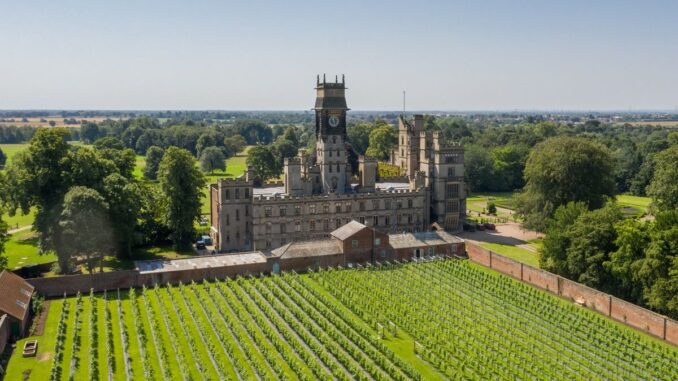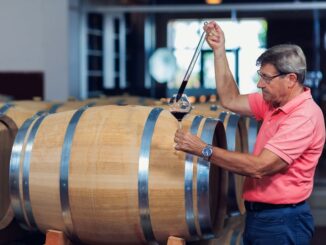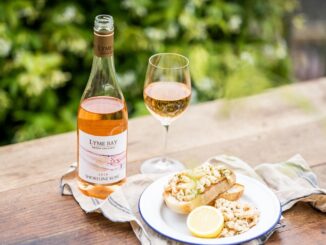
There’s nowt quite like a cellar door tasting at Market Farm on South Cave, a flute of Westow Erthksroy at Driffield, enjoying pan-fried venison haunch over a not-too-liquid lunch overlooking the Holme valley at the Sheveling Wine Estate, or enjoying the white blossom flavours afforded by Eleanor white or a Solaris Orange at Pool Lane, Nun Monkston.
They are all part of experiencing the Yorkshire Wine Trail. Wine tourism is becoming increasingly popular in the White Rose County. Tykes are now respected oenologists.
The family field-to-glass, 17 acre Yorkshire Heart Vineyard and Brewery at Nun Monkton specialises in fine English wine, as well as craft ales and pilsners. Supported by husband Chris, son Tim and wife Georgina, the chief winemaker is Skipton-born and bred Gillian Spakouskas. Chris and Gillian met at college in Preston. Chris was studying poultry farm management and Gillian dairy, who explains:
“It has been a slow but wonderful process full of highs and lows due to the good old Yorkshire weather! We envisaged planting just one acre as a serious hobby but have continued planting each year.”
Holmfirth Vineyard, on the edge of the Peak District has a hotel and restaurant. The Fletcher family’s Ryedale Vineyards at Far Field Farm at the foot of the Yorkshire Wolds offers bijou farmhouse accommodation. Jack is the head winemaker. It is the only place you can taste “Paradise”. It is the winery’s sparkling wine. It also makes Dalesman, Strickland Red and Yorkshire Lass and Lad.
All aspects of wine production from pruning to harvesting to pressing, fermenting, bottling and labelling are carried out by hand in the converted cow byre. The vineyard grows over 18,000 vines, many planted in 2006 producing around 8000 bottles of wine from 19 different grapes.
In East Yorkshire, Little Wold Vineyard is run by brother and sister, Alice and Tom Maltby. Their Phoenix and Madeleine Angevine Chalk Hill White 2022 was matured in stainless steel for around six months. As Alice says:
“It pairs perfectly with a creamy pasta dish or would accompany a roast chicken dinner on a Sunday. Tom’s Cuvee is a 100% Serval Blanc classic English fizz.”

Ian Sargent and his wife Anne had the idea of Laurel Vines on Aike Lane, Driffield in 2010. Ian studied viticulture via Plumpton College. Their 2013 the winery was equipped with the help of Chris and Gillian at Yorkshire Heart.
In 2015, Ian became the Chair for the Mercian Vineyard Association (Now Wine GB Midlands and North). In 2020, with six other Yorkshire winemakers, he set up the county’s Wine Trail, the first of its kind outside the southern counties of England.
The vineyards linked with local towns, cities and tourism bodies together with hotels and restaurants to provide a trail that could be followed to visit Yorkshire’s little known quality product wine, says Ian, who last year joined the Board of Wine GB as the Regional Director and represents all seven growing regions in Great Britian. He is MD of Sargent Electrical Services based in Beverley, East Yorkshire.
Ann Sargent looks after the day-to-day financial operations of the vineyard and winery. She is also the picnic host and tour guide. Daughter Rebekah co-ordinates sales, social media and the website. Husband Craig helps Jonathan Yeo, the vineyard manager who worked for Laurel Vines.
Leventhorpe is a long-established, award-winning vineyard situated in Leeds, founded in 1985 by George and Janet Bowden. It was the first to re-introduce commercial wine growing back into Yorkshire. And George says:
“The Cistercian monks of Kirkstall Abbey in Leeds had vineyards, although the exact location is unknown. The Benedictines at St Mary’s Abbey, York, had a well-documented vineyard of around 10 acres at Askham Richard on the outskirts of the City and had been making wine successfully up to the 16th century.
“Ours is one of the very few vineyards that lie within a large city boundary anywhere in the world. Between 18-26 metres above sea level, the site is on a south-facing slope leading down to the River Air. This helps protect the vines against spring frosts. The soil, sandy loam overlying sand and broken sandstone is free-draining and warms quickly.”
Wine critic Oz Clarke raved about Leventhorpe Madeleine Angevine.
“Queen of the North” wine is made by Dunesforde Vineyard owned and run by Ian and Mandy Townsend. Upper Dunsforth near York is their Tuscany. The vineyard was planted in 2016, with the first wines released in 2019. Youngest son Peter Townsend is Head of Wine Development.

Laura Hartley says:
“Our Queen of the North wines are named after Queen Cartimandua, the leader of the Brigantes tribe in Northern England from about AD43. Aldborough, just down the road from the vineyard, was a major Roman settlement and tablets at Vindolanda evidenced the buying of wine there. Cartimandua would have also crossed our land or at least passed close by. There is now a 27ft mural of Roman Aldborough in the Roman Room at Dunesforde, painted by local artist Lynn Ward.”
Queen Of The North Classic Cuvee 2019 is 70% Chardonnay, 30% Pinot Noir while Queen Of The North Rosé 2019 is 80% Pinot Noir and 20% Chardonnay.
The aristocracy are involved in Yorkshire wine too.
Lord and Lady Gerald Fitzalan Howard decided to convert their walled garden at Carlton Towers near Selby in North Yorkshire into a vineyard over 10 years ago where Chardonnay and Pinot Noir grapes are blended to produce a limited release Duke Miles English sparkling wine named after Lord Gerald’s father.
Not only has it a wine trail but Yorkshire also boasts a wine school. In Leeds Laura Kent set up the YWS after being made redundant when Oddbins went into administration. She runs WSET courses, hosts tasting and sets up private wine events.
“At the moment I think the best wines being made in Yorkshire tend to be sparkling. Because of the cool climate it’s hard to ripen grapes for still wines. We suggest pairing Yorkshire sparkling wine with fish and chips before a quintessential Yorkshire dish which really brings out the fresh acidity in the wine.
“Lots of the local wineries are working with less familiar grapes, things like Rondo, Regent, Seyval Blanc etc. as these have been bred specifically for a cooler climate. Most of the wineries offer excellent tasting and tour experiences.”
Author Bio:
Kevin Pilley is a former professional cricketer and chief staff writer of PUNCH magazine. His humour, travel, food and drink work appear worldwide, and he has been published in over 800 titles.





Be the first to comment